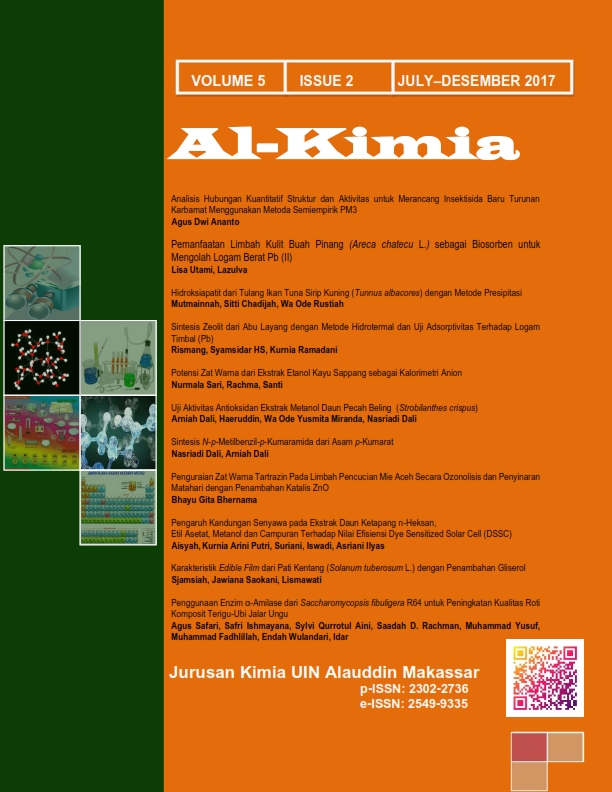Karakteristik Edible Film dari Pati Kentang (Solanum Tuberosum L.) dengan Penambahan Gliserol
Abstract
Edible film is a thin layer that serve as the packaging or upholstery as well as food that can be eaten with a product. It is packaged and can be degraded by nature. Potato starch can be used as raw material in manufacturing edible film, in which the addition of glycerol is needed as a plasticizer that function to improve the elasticity of the edible film. The goal of the research is to know the influence of glycerol concentration variation against the characteristics of edible film of starch potatoes (Solanum tuberosum L.) the parameters examined in this study i.e the physical test that includes a test of strong thickness, tensile test and present enlargement, test the solubility and organoleptic. To help figure out the data obtained in the real effect or not, is done using the SPSS Analysis Variant 1 direction or one-way ANOVA. Characteristics of edible film from potato starch with addition of glycerol with a concentration of 20%, 30% and 40% (v/v) to the value of the thickness of consecutive 0,058 mm, 0,062 mm and 0,071mm. The value of the tensile strengh i.e 0,75 N/mm2, 0,69 N/mm2 and 0,35 N/mm2. The value obtained by elongation percent 4,96%, 9,04% and 9,51% where as the value of solubility is obtained that is 19%, 21,4% and 34,6%. Application of edible films from potato starch as the packaging on candy jelly can be acceptedas alternative packaging material for food.
Downloads
References
AOAC, (1983). Official methods of Analysis, Edisi ke -14, Washington, DC: Association of Official Analytical Chemists.
ASTM D638-02a. (2002), Standard Test Methods for Tensile Properties of Plastics, Philadelphia, PA: American Society for Testing and Material.
Ariska, R.E & Suyatno. (2013). Pengaruh konsentrasi karagenan terhadap sifat fisik dan mekanik edible film dari dari pati bonggol pisang dan karagenan dengan plasticizer gliserol, Prosiding Seminar, 2(1), 34-40.
Coniwanti P, Laila L., Alfira, M.R., (2014), Pembuatan film plastik biodegredabel dari pati jagung dengan penambahan kitosan dan pemlastis gliserol, Jurnal Teknik Kimia, 20(4), 22-30.
Cornelia, M., et.al., (2012). Pengaruh penambahan pati bengkoang terhadap karakteristik fisik dan mekanik edible film, Jurnal Kimia Kemasan, 34(2), 263-271.
Fatimah, C. 2013. Physical-mechanical properties and microstructure of breadfruit starch edible films with various plasticizer. Eksakta, 13(1), 1-7.
Huri, D & Fithri C. N, 2014, Pengaruh konsentrasi gliserol dan ekstrak ampas kulit apel terhadap karakteristik fisik dan kimia edible film. Jurnal Pangan dan Agroindustri, 2(4), 29-40.
Koswara, S. (2009), Teknologi Pembuatan Permen, 1-60.
Krisna, A. (2011), Pengaruh regelatinasi dan modifikasi hidrotermal terhadap sifat fisik pada pembuatan edible film dari pati kacang merah (Vigna angularis Sp.), Tesis Magister Teknik Kimia Universitas Diponegoro, Semarang, 1-61.
Kusnadi & Budyanto. (2015). Antibacterial active packaging edible film formulation with addition teak (Tectona grandis) leaf extract. International Jurnal of Life Science Biotechnology and Pharma Research, 4(2), 79-84.
Niken H. (2013). Isolasi amilosa dan amilopektin dari pati kentang, Jurnal Teknologi Kimia dan Industri, 2(3), 57-62.
Ridal S. (2003). Karakterisasi sifat fisiko-kimia tepung dan pati talas (Colosocia esculenta) dan kimpul (Xanthosoma Sp) dan uji penerimaan a-amilase terhadap patinya. Skripsi Teknologi Pertanian, 1-74.
Copyright (c) 2017 Sjamsiah Sjamsiah, Jawiana Saokani, Lismawati Lismawati

This work is licensed under a Creative Commons Attribution-NonCommercial-ShareAlike 4.0 International License.
Authors who publish with this journal agree to the following terms:
1) Authors retain copyright and grant the journal right of first publication with the work simultaneously licensed under a Creative Commons Attribution License that allows others to share the work with an acknowledgement of the work's authorship and initial publication in this journal.
2) Authors are able to enter into separate, additional contractual arrangements for the non-exclusive distribution of the journal's published version of the work (e.g., post it to an institutional repository or publish it in a book), with an acknowledgement of its initial publication in this journal.
3)Authors are permitted and encouraged to post their work online (e.g., in institutional repositories or on their website) prior to and during the submission process, as it can lead to productive exchanges, as well as earlier and greater citation of published work (See The Effect of Open Access).


